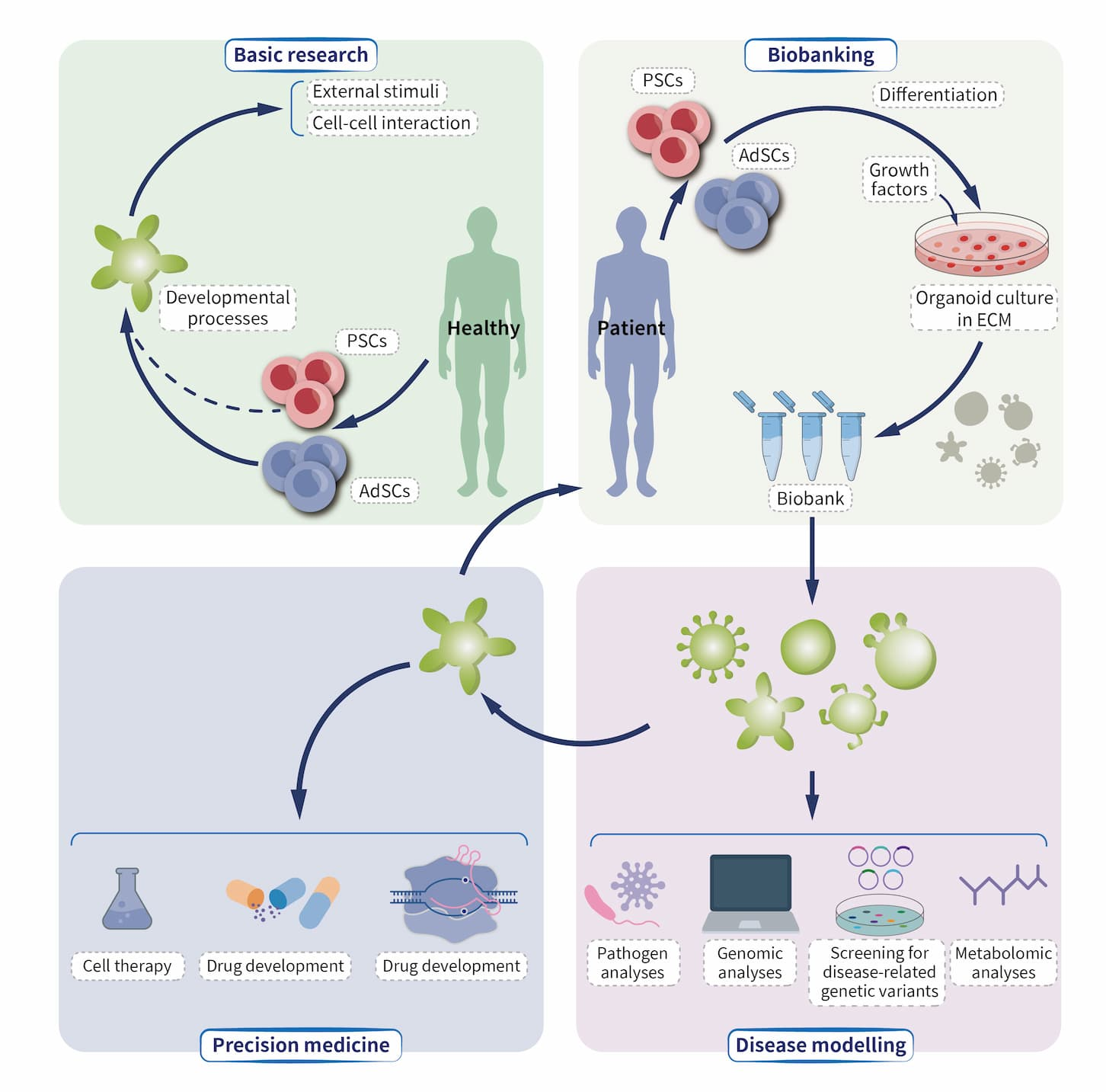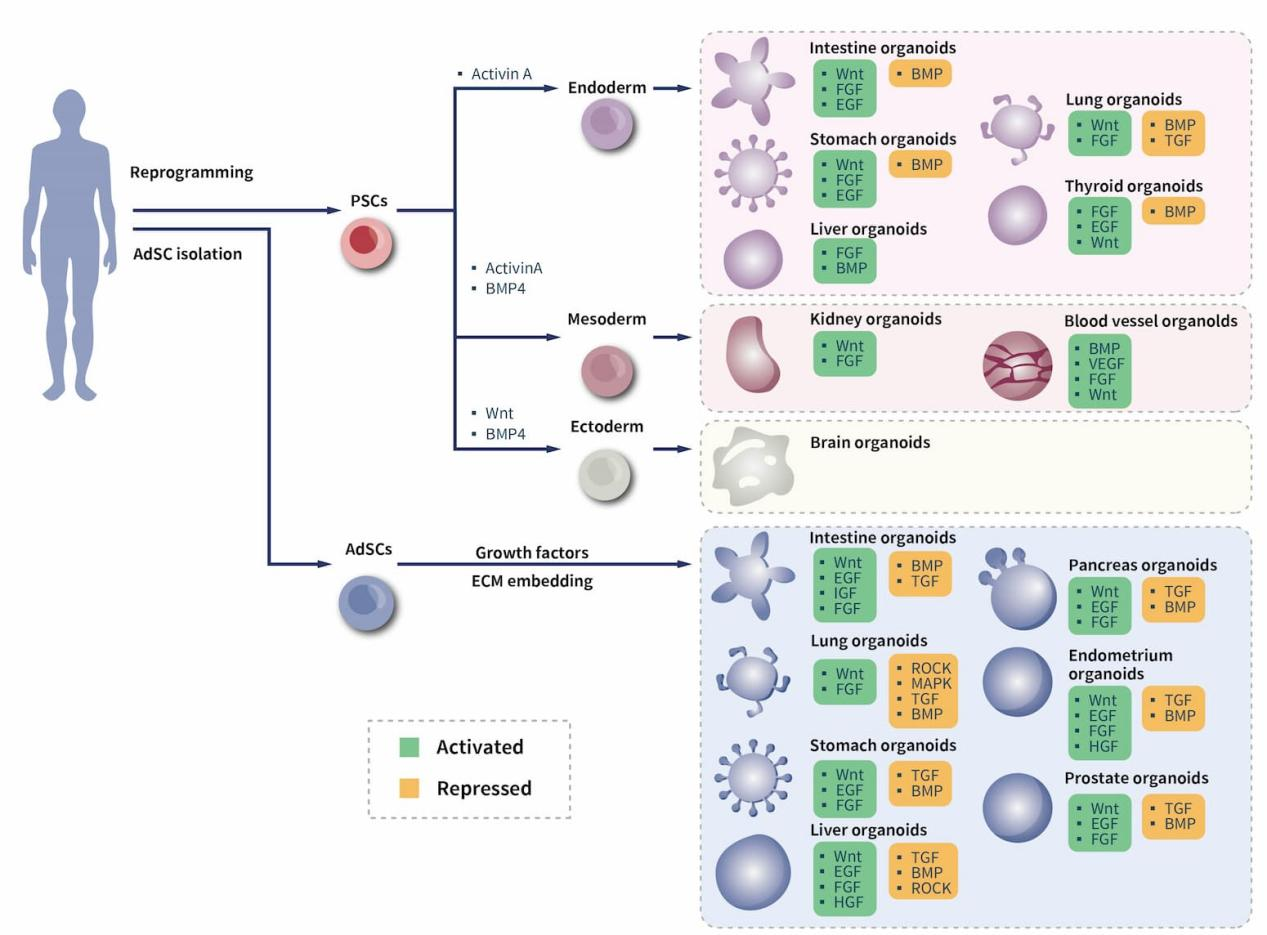The development of organoids
Initially, the organoid model started from in vitro culture experiments of an animal embryo. The traditional cell culture model gradually advanced to a 3D spatial structure through the development of extracellular matrix-embedded culture and cell reprogramming technology. In 2009, a landmark study found that adult intestinal stem cells expressing G protein-coupled receptor 5 (Lgr5) could differentiate into crypt villi in matrigel to form 3D intestinal organoids, laying the foundation for organoids of other systems. Recently, by modifying the combination of growth factors and cell isolation procedures, organoid models including stomach, liver, pancreas, lung, kidney, brain, and retina have been developing.
The application of organoids
The organoid model is a three-dimensional culture system derived from induced pluripotent stem cells (iPSCs) or adult stem cells (AdSCs), with the application as the following:
· Complex spatial forms similar to human tissues or organs
Compared with the traditional two-dimensional cell culture model, organoids can reflect the interaction between different cells and between cells and substrates and even show similar physiological responses under ideal conditions.
· Individual organoid models
Organoid models overcome the species differences between traditional preclinical animal models and the human body. Moreover, it retains the advantages of large-scale screening and gene editing feasibility of cell models, which can be applied to the screening of drug effectiveness and toxicity.
· Database establishment
By establishing and comparing organoid models of ordinary people and patients, considerable data on pathological mechanisms, including cancer, infectious diseases, and genetic diseases, can be collected and analyzed.

Culture of stem cell and organoid
The improvement of pluripotent stem cell and progenitor cell isolation technology as well as the optimization of culture conditions have promoted the development of organoid models. Among them, organoid stem cells are mainly derived from iPSCs and AdSCs. Their characteristics are described below:
|
Induced pluripotent stem cell (iPSC) |
Adult stem cell (AdSC) |
|
Undergo Reprogramming |
Obtained from regenerative adult tissues |
|
Time-consuming |
Simpler procedure with a shorter time frame |
|
Forming process is similar to embryonic development |
Maturity is closer to that of adult tissue |
|
Relatively complex components (include stroma, nerves, immune cells, and vasculature) |
Relatively low structural complexity |
|
Suitable for studying early organogenesis |
Can be expanded for a long time while maintaining gene stability |
|
Severe acute respiratory syndrome coronavirus 2 (SARS-CoV-2) |
Respiratory syncytial virus (RSV) |

After being mixed with an extracellular matrix (ECM), iPSCs or AdSCs are able to differentiate into specific tissue with spatial structures similar to organs under the induction of different growth factors combination. Wnt, EGF, FGF, R-spondin 1, and BMP are important growth factors that mainly affect the differentiation of most stem cells. Therefore, the development of activity- retained recombinant proteins that promote the growth and differentiation of stem cells will help establish organoid models and promote the research of stem cells development.
The limitation and development of organoid
There are still some challenges needed to be overcome. For example, the standardization of culture conditions consequently makes organoid models established with different protocols between labs difficult to be compared. Nevertheless, several organoid models have been used in biomedical research and drug screening. In addition, studies have begun to test the therapeutic effect of organoid transplantation in animal models. Overall, organoid models have previously been and continue to be useful for biomedical research and individualized medicine. It has been well-accepted that organoids will have great potential and broad applications in the years to come.
Related Products:
|
Cat# |
Product Name |
|
CM181-1000HP |
Recombinant R-Spondin 1,Human,AF |
|
CM181-100HP |
|
|
CM181-20HP |
|
|
CM181-500HP |
|
|
CM120-10000HP |
Recombinant EGF,Human,AF |
|
CM120-1000HP |
|
|
CM120-100HP |
|
|
CM120-5000HP |
|
|
CM120-500HP |
|
|
CM172-1000HP |
Recombinant Noggin,Human,AF |
|
CM172-100HP |
|
|
CM172-20HP |
|
|
CM172-500HP |
|
|
CM172-5HP |
|
|
CM118-1000HP |
Recombinant Activin A,Human/Mouse/Rat,AF |
|
CM118-100HP |
|
|
CM118-20HP |
|
|
CM118-500HP |
|
|
CM118-5HP |
|
|
CM091-1000HP |
Recombinant FGF-2 (154 a.a.),Human(FGF-basic),AF |
|
CM091-100HP |
|
|
CM091-20HP |
|
|
CM091-500HP |
|
|
CM063-5HP |
Recombinant BMP-2,Human,AF |
|
CM063-20HP |
|
|
CM063-100HP |
|
|
CM063-500HP |
|
|
CM063-1000HP |
|
|
CM065-1000HP |
Recombinant BMP-4,Human,AF |
|
CM065-100HP |
|
|
CM065-20HP |
|
|
CM065-500HP |
|
|
CM065-5HP |
|
|
CM050-1000HP |
Recombinant BAFF,Human,AF |
|
CM050-100HP |
|
|
CM050-20HP |
|
|
CM050-500HP |
|
|
CM050-5HP |
|
|
CM135-1000HP |
Recombinant BDNF,Human/Mouse,AF |
|
CM135-100HP |
|
|
CM135-20HP |
|
|
CM135-500HP |
|
|
CM135-5HP |
|
|
CM068-1000HP |
Recombinant BMP-7,Human,AF |
|
CM068-100HP |
|
|
CM068-20HP |
|
|
CM068-500HP |
|
|
CM068-5HP |
|
|
CM053-1000HP |
Recombinant CD40L,Human,AF |
|
CM053-100HP |
|
|
CM053-20HP |
|
|
CM053-500HP |
|
|
CM053-5HP |
|
|
CM113-20HP |
Recombinant IGF-I,Human,AF |
|
CM113-100HP |
Recombinant IGF-I,Human,AF |
|
CM113-500HP |
Recombinant IGF-I,Human,AF |
|
CM113-1000HP |
Recombinant IGF-I,Human,AF |
|
CM099-1000HP |
Recombinant FGF-10,Human,AF |
|
CM099-100HP |
|
|
CM099-20HP |
|
|
CM099-500HP |
|
|
CM099-5HP |
|
|
CM108-1000HP |
Recombinant FGF-19,Human,AF |
|
CM108-100HP |
|
|
CM108-20HP |
|
|
CM108-500HP |
|
|
CM108-5HP |
|
|
CM093-1000HP |
Recombinant FGF-4,Human,AF |
|
CM093-100HP |
|
|
CM093-20HP |
|
|
CM093-500HP |
|
|
CM093-5HP |
|
|
CM098-1000HP |
Recombinant FGF-9,Human,AF |
|
CM098-100HP |
|
|
CM098-20HP |
|
|
CM098-500HP |
|
|
CM098-5HP |
|
|
CM138-1000HP |
Recombinant GDNF,Human,AF |
|
CM138-100HP |
|
|
CM138-20HP |
|
|
CM138-500HP |
|
|
CM138-5HP |
|
|
CM088-1000HP |
Recombinant TGF beta 1,Human,AF |
|
CM088-100HP |
|
|
CM088-20HP |
|
|
CM088-500HP |
|
|
CM088-5HP |
References:
1.https://www.sigmaaldrich.com/TW/en/technical-documents/technical-article/cell-culture-and-cell-culture-analysis/3d-cell-culture/3d-organoid-culture
2. https://www.nature.com/articles/s41580-020-0259-3
3. https://cellandbioscience.biomedcentral.com/articles/10.1186/s13578-022-00775-w
4. https://www.ncbi.nlm.nih.gov/pmc/articles/PMC8026469/
5. https://www.nature.com/articles/s41392-022-01024-9
6. https://www.atcc.org/resources/culture-guides/organoid-culture-guide
 Follow Us
Follow Us